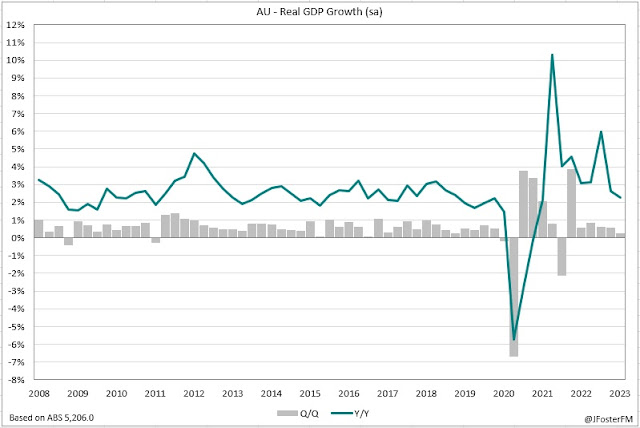Growth in the Australian economy slowed to 0.2% in the March quarter from a 0.6% pace in the final quarter of last year. Excluding the Covid period, this was the weakest quarterly growth rate seen since late 2018. Growth over the year eased from 2.6% to 2.3%, underpinned by rapid population growth (2%) on reopened borders.
The inflationary risks the RBA highlighted in yesterday's decision to hike rates by a further 25bps to 4.1% and then in a speech by Governor Lowe this morning were evident in the National Accounts. Although hourly earnings (2.7%Y/Y) don't provide cause for alarm, the RBA points out that measured productivity has declined (-4.5%Y/Y), or in other words, hours worked have been increasing at a faster pace than output growth. Labour costs adjusted for productivity are, therefore. elevated (7.9%Y/Y), which Governor Lowe says is presenting a risk to its objective to lower inflation back to the 2-3% target "within a reasonable timeframe".
Household consumption softened further in Q1 (0.2%) amid ongoing pressures on budgets. The post-Covid rebound has dried up as consumption rotated away from discretionary areas (-1%) to essentials (1.1%). Real incomes continue to decline, now down by more than 4% over the past year as high inflation has outpaced rising wages associated with the strong labour market. Further pressure came from rising interest rates, with much more tightening still in the pipeline. Mortgage payments increased to a 6% share of disposable income in the quarter, its highest share in almost a decade. Because of all this, households are now saving less - the saving ratio fell to a 15-year low of 3.7%. But savings built up over the Covid period were substantial and are being used to support household consumption.
Despite slower household consumption growth, domestic demand picked up to rise by 0.6% in the quarter. This was driven by a welcome uplift in business investment (2.9%) that was broad-based across construction (2.3%), equipment (4.9%) and other components (0.8%). Dwelling investment, however, continues to slide (1.2%q/q and -4.4%Y/Y); supply pressures, rising interest rates and earlier declines in housing prices weighed on home building while alterations are unwinding after surging during the pandemic.
Eased supply chains and rising business investment supported a rebound in imports (3.2%), which outpaced exports (1.8%) to result in net exports making a 0.2ppt deduction from quarterly growth. But exports (10.8%) have risen at more than twice the pace of imports (5.8%) over the past year. Services exports have surged (49.7%) as the reopening of the borders has facilitated the recovery in the tourism and education sectors. This effort has bolstered the Australian economy as spending by domestic households has slowed, contributing 2ppts to GDP over the past year.





